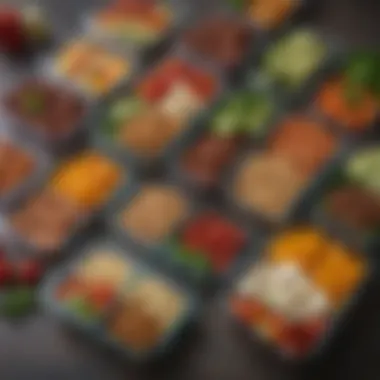Homemade Meals to Go: Practical Tips and Recipes


Intro
In the fast-paced society we live in, convenience often trumps nutrition. Many people turn to pre-packaged meals or fast food, compromising health for speed. However, the concept of homemade meals to go presents a balanced approach. It combines the ease of preparation with the health benefits of cooking at home. This guide explores different aspects of preparing, storing, and transporting homemade meals while ensuring they meet various dietary preferences and needs.
The preparation of homemade meals has several advantages. Individuals can control ingredients, making meals healthier than many store-bought options. Additionally, planning meals in advance can save both time and money. It also contributes to less food waste since you can better manage portions and ingredients.
Throughout this article, we will look into several components that make homemade meals feasible for busy lifestyles. Readers can expect insights into crucial preparation techniques, appropriate storage solutions, and diverse recipe ideas. This resource aims to inspire readers to integrate homemade meals into their routines, ultimately leading to healthier eating habits.
Key Points Covered
- The benefits of homemade meals
- Essential meal planning strategies
- A selection of easy-to-follow recipes
- Advice on transport to ensure meal quality
By approaching meal efforts in a structured manner, even the busiest individuals can achieve a practical and nutritious approach to dining.
Foreword to Homemade Meals
In today's fast-paced world, homemade meals often provide a necessary retreat from the chaos of takeout and processed options. From busy professionals to families on the go, the importance of preparing meals at home cannot be understated. This section establishes a foundational understanding of homemade meals, highlighting their relevance and multifaceted nature in modern society.
Defining Homemade Meals
Homemade meals are typically defined as dishes prepared in one's own kitchen, using fresh ingredients rather than pre-packaged or restaurant offerings. These meals are characterized by their simplicity and the ability to cater to personal tastes. Unlike store-bought options, homemade meals allow for greater customization, enabling individuals to choose their ingredients, control portions, and avoid unnecessary additives. This control over components leads to meals that can better align with dietary preferences and health goals, making them a superior option for many.
The Rise of Meal Prep Culture
In recent years, meal prep has surged in popularity, serving as a response to both the need for convenience and healthier eating habits. The concept revolves around preparing multiple meals in advance, allowing individuals to save time during busy days. This movement has been propelled by social media platforms, where users share their meal prep journeys and creative ideas. As a result, meal prep culture has not only transformed how people think about food, but it also encourages a mindset focused on planning and efficiency. Preparing homemade meals in advance helps individuals avoid unhealthy choices, thereby promoting better nutrition in a world dominated by convenience foods.
Benefits of Homemade Meals
Homemade meals offer significant advantages that resonate with individuals seeking convenience, health, and cost savings. Understanding these benefits is essential for anyone considering meal preparation at home. This section illustrates the compelling reasons why homemade meals can enhance your lifestyle, providing necessary insight for food lovers.
Nutritional Advantages
One pivotal benefit of homemade meals is their nutritional value. When you cook at home, you have direct control over the ingredients and cooking methods. This empowers you to choose fresh vegetables, lean proteins, and whole grains, minimizing the usage of unhealthy fats and added sugars. Unlike many restaurant or pre-packaged meals, homemade options often lack excessive salt and preservatives, which can adversely affect health.
Furthermore, the ability to customize meals according to specific dietary needs is crucial. For instance, you can easily modify recipes to cater for allergies or intolerances.
- Choose gluten-free grains like quinoa or brown rice.
- Incorporate a variety of colorful vegetables for maximum nutrients.
- Adjust portion sizes based on personal health goals.
This level of control ultimately leads to a healthier diet, facilitating better long-term health outcomes.
Cost-Effectiveness
Cooking at home can also be significantly more economical compared to dining out or purchasing ready-made meals. Buying ingredients in bulk often reduces costs per serving. For instance, a pound of dry lentils is far cheaper than a single lentil salad from a cafe. Here is a quick comparison:
- Homemade Lentil Soup: Cost = ingredients for multiple servings.
- Restaurant Lentil Salad: Cost = price for one serving, often marked up.
By planning meals, you can also reduce waste. Leftovers can be transformed into new dishes, saving both money and time. Budget-conscious individuals find this aspect particularly appealing, as it encourages thoughtful consumption and minimizes food waste.
Personalization and Control
Another noteworthy advantage of homemade meals is the level of personalization they offer. Everyone has unique tastes and preferences, and homemade cooking allows for flexibility that is often not possible in store-bought options. You can experiment with flavors, spices, and cooking techniques to create dishes that reflect your culinary inclinations.
This customization can enhance the dining experience.
- Have a preference for spicy food? Add some chili flakes.
- Prefer lighter flavors? Use herbs like basil or parsley instead.
- Follow a specific diet? Easily swap ingredients to meet nutritional needs.
Alongside personalization, cooking at home gives you greater control over serving sizes, which can aid in managing portion control and aligning with your dietary goals. In essence, the benefits of homemade meals encapsulate a holistic approach to food that supports health, cost savings, and personal satisfaction.
"Cooking at home is not just about food. It is an opportunity to cultivate health, creativity, and satisfaction."
Planning Your Meals
Effective meal planning is not just about deciding what to eat on a weekly basis. It plays a crucial role in the overall success of preparing homemade meals to go. By creating a structured plan, you can maximize your time, reduce food waste, and ensure that you have healthy options at your fingertips. This practice allows you to align meals with your nutritional needs and flavor preferences, providing better control over your diet and finances.


Planning your meals can mitigate the stresses associated with last-minute cooking or decision fatigue. With a detailed blueprint in place, you will arrive at a better understanding of how to utilize ingredients wisely, which supports both a balanced diet and cost-effective shopping. When meals are pre-determined, it also becomes easier to limit unhealthy takeout options that can disrupt healthy eating habits.
Creating a Weekly Meal Plan
A weekly meal plan can serve as the backbone of your cooking routine. Start by identifying meals that you enjoy and want to prepare throughout the week. Consider factors like your schedule, the time available for cooking, and the dietary preferences of anyone who will be sharing your meals.
- Select a variety of dishes: Include a balance of proteins, vegetables, and grains to ensure nutritional diversity. For instance, mix stir-fries, salads, and pasta dishes to keep meals interesting.
- Decide on meal frequencies: Determine how many meals you need to prepare. Will you be cooking for just weekdays or include the weekend as well? Adjust the number based on your lifestyle and cooking willingness.
- Consider batch cooking: If you find certain recipes lend themselves to being made in larger quantities, integrate these into your planning. It can save time and effort later in the week.
- Make adjustments as needed: Stay flexible. Life can be unpredictable, so if a scheduled meal doesn’t work out, consider easy substitutions that fit within your overarching plan.
Shopping for Essentials
Once your weekly meal plan is established, the next logical step is shopping for essentials. Having a focused grocery list helps in making efficient and informed purchasing decisions. This can reduce impulse buys and ensure you're stocked up with the necessary ingredients.
- Create a categorized shopping list: Organize your list based on sections of the grocery store: produce, proteins, grains, etc. This approach streamlines the shopping process and reduces the time spent wandering the aisles.
- Buy in bulk when possible: For staples like grains, canned goods, and frozen vegetables, buying in bulk can be a cost-effective strategy. Just be sure to store them properly to maintain freshness.
- Be mindful of seasonal produce: Purchasing seasonal fruits and vegetables not only supports local economies but also ensures better flavor and nutrition. Check local markets for what’s available at the time of your shopping.
- Prioritize quality: While cost is important, make sure to invest in quality ingredients, especially for proteins and fresh produce. These components have a significant impact on the final flavor and healthfulness of your meals.
Meal planning and savvy shopping create a symbiotic relationship that enhances the cooking experience, ensuring homemade meals remain both convenient and enjoyable.
Techniques for Preparing Meals
Cooking at home provides countless opportunities for health and creativity. It becomes easier when you understand key techniques for preparing meals. Not only does this knowledge allow for efficient meal preparation, but it also garners significant savings in both time and money. Implementing these techniques can streamline the cooking process and enable you to maximize resources, thereby enhancing the overall experience of homemade meals to go.
Batch Cooking Basics
Batch cooking is a strategic approach that involves preparing multiple meals at once. This technique simplifies the daily cooking routine, saving both time and effort. By setting aside a few hours to prepare a larger quantity of food, you can divvy it up into smaller portions for the rest of the week.
For example, cooking a big pot of chili, soup, or stew is a smart move. These meals store well and can be frozen for future use. When using batch cooking, it is vital to focus on ingredients that complement one another. This enables you to create a variety of dishes from the same base components. Items such as grains, beans, or proteins can be seasoned differently to create unique meals throughout the week.
Benefits of Batch Cooking:
- Efficiency: Less time spent cooking throughout the week.
- Reduced Waste: Use up ingredients before they spoil.
- Healthier Choices: Control over ingredients, leading to better nutrition.
- Cost-Effective: Buying ingredients in bulk often reduces cost.
In order to get started with batch cooking, consider planning a menu that emphasizes versatile ingredients and flavors. For instance, one week you might choose quinoa, and throughout the week you can prepare salads, bowls, or soups with that same base.
Using Leftovers Creatively
Utilizing leftovers can be an art. It is an often overlooked aspect of meal preparation that can save time and reduce waste. Creative use of leftovers allows for new meal options, leading to culinary variety without extra cooking.
Transforming leftover chicken into a salad or tacos, or repurposing roasted vegetables into a frittata, showcases the potential that leftover food holds. This not only helps avoid the monotony of eating the same dish repeatedly, but it also encourages experimentation with new flavors and textures.
Identifying how to use leftovers can involve simple techniques, such as:
- Storage: Store leftovers in clear containers to keep them visible.
- Mixing: Combine different leftovers into a whole new meal.
- Freezing: When unsure about using certain items soon, freezing can prevent spoilage.
"Creatively using leftovers reduces waste while keeping the meals fresh and exciting."
The beauty of incorporating leftovers into your meals lies in its simplicity. It requires minimal preparation and presents an opportunity to reinvent what you already have at hand. Ultimately, these techniques not only contribute to effective meal preparation; they also foster a more sustainable approach to cooking, encouraging a mindset that values both nutrition and responsible resource management.
Storage Solutions
The significance of storage solutions cannot be understated when it comes to homemade meals. Proper storage not only preserves the quality and taste of food, but it also ensures safety and convenience for on-the-go lifestyles. By implementing effective storage techniques, you can extend the shelf life of your meals, minimize waste, and make meal prep a seamless part of your routine. Understanding the different container options and freezing methods is essential for ensuring that your hard work in the kitchen translates into meals that last.
Proper Containers for Meal Storage
Selecting the right containers is pivotal for effective meal storage. There are various materials available, each with its benefits. Glass containers are a popular choice due to their ability to withstand high temperatures and their non-reactive nature, which does not alter the flavor of your food. Plastic containers, while lightweight and convenient, should be BPA-free to avoid any health risks.
When storing meals, ensure that the containers are airtight to prevent moisture accumulation and preserve freshness. Consider investing in different sizes to accommodate varying meal portions. Additionally, look for stackable options that save space in your refrigerator or freezer.
Some practical tips include:
- Labeling: Clearly label containers with the meal name and date of storage. This helps you keep track of freshness.
- Serving Sizes: Portion meals appropriately to make reheating easier and to prevent food waste.
Freezing Techniques for Long-Term Use
Freezing is one of the best methods for long-term meal storage. It allows you to prepare meals in advance and have them ready whenever you need them. To freeze meals effectively, follow these steps:
- Cool Before Freezing: Ensure your food is cooled to room temperature. Hot food can raise the temperature inside the freezer, affecting other items.
- Use Freezer-Safe Containers: Just like with regular meal storage, use containers specifically designed for freezing. Vacuum-sealed bags are excellent for removing air that can cause freezer burn.
- Portion Your Food: Divide meals into individual portions. This allows for easier reheating and reduces the chance of thawing food that won’t be eaten immediately.
- Keep a Rotation Schedule: Use the oldest meals first to maintain freshness. A simple system of rotation can keep your meals in prime condition.


According to food safety guidelines, most cooked meals can be safely frozen for up to three months. This ensures you can enjoy a variety of meals without compromising quality.
By mastering these storage solutions, you can ensure that your homemade meals remain fresh and delicious, making it easier to incorporate healthy eating into your busy routine.
Transportation Tips
In the fast-paced environment of modern life, the way we transport meals has become increasingly important. Transportation tips are essential for anyone looking to enjoy homemade meals on the go. Whether heading to work, school, or an outdoor activity, understanding how to maintain the quality and freshness of meals contributes significantly to the overall enjoyment and healthiness of the food.
When preparing homemade meals, additional considerations come into play. Not only should the meals be ready to eat, but they must also survive the trip without losing their appeal. Utilizing the right packaging and methods for transportation can prevent spoilage, leakage, or mixing of flavors, which is often undesirable.
Keeping Meals Fresh on the Go
Maintaining freshness during transportation is crucial for ensuring that meals do not degrade in quality. Several strategies achieve this:
- Use Insulated Containers: Insulated food jars and bags help keep meals at the required temperature for extended periods. This is especially necessary for hot soups or cold salads.
- Utilize Ice Packs: When packing perishable items, adding ice packs can help maintain freshness. This is significant for dishes containing dairy, meat, or seafood.
- Choose the Right Ingredients: Opt for ingredients that are resilient and less prone to spoilage. For instance, salads can wilt quickly, but grain-based salads remain fresh longer.
"Keeping meals fresh is not just about taste; it is about food safety and health."
Knowing these preparation methods enhances the quality of the meal, ensuring that it tastes great and is safe to consume.
Best Practices for Packing Meals
Packing meals correctly can make a significant difference in their quality once at the destination. Here are essential packing tips:
- Group Ingredients Separately: Keep sauces, dressings, or toppings separate until ready to eat. This keeps everything fresh and prevents sogginess.
- Seal Tightly: Make sure all containers are sealed properly to avoid spills. Leaking can not only make a mess but also ruin the meal's overall appeal.
- Choose Appropriate Sized Containers: Use containers that fit the portion sizes. Too much air in the container can encourage spoilage, while too small could lead to compression or squash the food.
Incorporating these strategies ensures that your homemade meals are still delightful when it's time to eat. A thoughtful approach to meal transportation is just as critical as the cooking process itself.
Recipe Ideas for Homemade Meals
Incorporating recipe ideas in the context of homemade meals elevates the overall appeal and practicality of meal prep. These ideas serve not only as inspiration but also as a means to diversify your dietary choices. They can help individuals maximize flavors while adhering to personal dietary needs and constraints. Given the fast-paced nature of modern life, having simple yet nutritious meal options readily available is essential. This section introduces a variety of recipes that are easy to prepare, transport, and consume.
Quick and Easy Lunch Options
Salad Jars
Salad jars are a practical choice for meal prep, offering a portable solution packed with nutrients. The key characteristic of salad jars is their layered structure, which keeps ingredients like greens, proteins, and dressings separate until it's time to eat. This prevents sogginess and maintains freshness. A notable advantage is that salad jars can be customized according to personal preferences, making them a versatile option. However, a minor downside is that not all ingredients have the same shelf life, which necessitates careful selection to avoid spoilage.
Wraps
Wraps present another efficient method for packing a satisfying lunch. They offer an easy-to-eat format and can be filled with a variety of fillings, from proteins to vegetables. The key aspect of wraps is their convenience and portability. With minimal preparation time, wraps can be tailored according to dietary preferences, making them a popular choice for busy individuals. The only disadvantage might be that certain wraps may not hold together well during transportation, potentially leading to mess.
Grain Bowls
Grain bowls are a nourishing option that combines whole grains with various toppings. The unique feature of grain bowls lies in their adaptability, allowing for numerous combinations of ingredients. They are filling and provide a balanced meal with grains, vegetables, and proteins. The versatility makes grain bowls a favorable option. However, preparation can take longer if multiple components need to be cooked separately. It’s crucial to plan accordingly to streamline the assembly process.
Hearty Dinner Recipes
Stir-Fries
Stir-fries are an excellent choice for creating a satisfying dinner in a short time. The defining aspect of stir-fries is their quick cooking method, preserving the freshness and nutrients of the ingredients. This method allows for an array of flavors and textures in one dish, appealing to various palates. A benefit of stir-fries is that they can be prepared in large batches, making it easy to pack leftovers for lunch the next day. However, one challenge is ensuring even cooking without burning.
Casseroles
Casseroles provide a comforting and hearty meal option that appeals to many. The main characteristic of casseroles is their ability to blend diverse ingredients into a single dish, making for easy serving and little waste. They often benefit from using pantry staples, simplifying preparation. This meal type is ideal for feeding families or groups. On the downside, casseroles may require longer cooking times, which can complicate last-minute meal planning.
One-Pot Meals
One-pot meals simplify cooking and cleanup and are incredibly efficient for busy weeknights. These meals allow various ingredients to meld together, enhancing flavor profiles. Their main advantage is convenience, as everything cooks in one vessel. This method reduces cooking time and minimizes dishwashing. However, it can be challenging to balance cooking times and ensure even texture among various ingredients.
Healthy Snacks for On-the-Go
Energy Balls
Energy balls represent a great snack for on-the-go nourishment. These small bites are typically made from nutrient-dense materials like nuts and oats. Their main advantage lies in their portability and potential for customization, matching different health goals. A slight disadvantage is that depending on the ingredients, their caloric density can be higher, so portion control becomes essential.


Veggie Chips
Veggie chips provide a crunchy, satisfying alternative to traditional snacks like regular chips. Their key characteristic is that they offer a way to enjoy vegetables in a convenient format. They can be homemade, ensuring no preservatives are included. However, some store-bought versions might lack fiber and other nutrients found in whole vegetables, limiting their health benefits.
Fruit Bars
Fruit bars are an easy way to get a quick energy boost while being portable and tasty. Typically made with whole fruits and grains, they provide natural sweetness without added sugars. A key advantage is their quick preparation and sleek storage options. Nonetheless, care should be taken to choose bars with minimal processing to retain nutritional value.
Planning meals ahead of time can greatly simplify your week, reducing stress and helping you stick to healthier choices.
Dietary Considerations
Understanding dietary considerations is vital when discussing homemade meals. These meals can be tailored to fit various dietary needs, thus promoting better health and overall well-being. With increasing prevalence of food allergies, intolerances, and lifestyle choices such as veganism, it is essential to acknowledge how homemade meals can accommodate different preferences and requirements. This section will explore three specific dietary considerations: vegan and vegetarian options, gluten-free recipes, and low-carb alternatives.
Vegan and Vegetarian Options
For those who follow vegan or vegetarian diets, homemade meals can be a canvas for creativity. Choosing plant-based meals allows for diverse nutrient intake while avoiding animal products. Popular options include chickpea salads, vegetable stir-fries, and hearty lentil soups. Not only do these meals provide essential proteins and fibers, but they also offer numerous health benefits such as lowered cholesterol levels and improved digestion.
Incorporating more vegetables is a key focus for vegan and vegetarian meal prep. For instance, meal-prepping options like quinoa salad, stuffed bell peppers, and zoodles (zucchini noodles) can easily be created in bulk. This approach not only saves time but also ensures an array of nutrients.
Gluten-Free Recipes
Gluten-free diets are necessary for those with celiac disease or gluten intolerance. Preparing meals at home provides the best control over ingredients. Gluten-free grains like rice, quinoa, and buckwheat serve as excellent substitutes for traditional grains in various recipes.
When working on gluten-free meal prep, consider using ingredients such as almond flour or coconut flour for baking, alongside fresh vegetables and high-quality proteins. Recipes like gluten-free pasta dishes or caulifower rice can be filling and satisfying. They can be made in advance and stored for easy access during a busy week.
Low-Carb Alternatives
Low-carb diets are gaining traction due to their effectiveness in weight management. For those following this lifestyle, meal prep is essential for success. Emphasizing proteins and healthy fats while minimizing carbs can lead to substantial weight loss and improved metabolic health.
Preparation includes utilizing vegetables like cauliflower and broccoli as substitutes for higher-carbohydrate ingredients. Options such as cauliflower pizza crust, zucchini lasagna, and baked chicken with asparagus can be great low-carb alternatives. Planning meals ahead of time is beneficial. It helps avoid the pitfalls of dining on high-carb convenience meals during hectic weeks.
"Dietary considerations can dramatically impact one's overall health. Customizing meals to meet specific needs not only improves taste but also promotes better nutrition."
By addressing these dietary considerations, the goal is to create a framework for anyone looking to enjoy homemade meals while respecting their food preferences and health requirements. Each meal can be prepared thoughtfully, making it easier for individuals to enjoy food without compromising their dietary needs.
Common Challenges in Meal Prep
Meal preparation can be a rewarding experience that promotes healthier eating habits and reduces food waste. However, it also comes with common challenges that can discourage even the most enthusiastic home cooks. Recognizing these hurdles is essential for effective meal planning and execution. Addressing these issues can help ensure that the time spent in the kitchen translates to positive outcomes.
Time Management Strategies
Managing time effectively is one of the crucial aspects of meal prep. Many people find that their busy schedules often conflict with their desire to prepare homemade meals. Utilizing specific time management techniques can greatly enhance productivity in the kitchen and ensure meals are prepared without stress.
- Set Aside Time: Designate a specific time each week for meal prep. This creates a routine and sets expectations. Many people find Sundays ideal for this purpose.
- Plan Ahead: Developing a meal plan at the start of each week can save time. Write out what meals you will make and gather the necessary ingredients in advance. This minimizes unexpected trips to the grocery store during your most hectic moments.
- Use a Timer: For those who tend to lose focus, setting a timer can promote efficiency. Knowing there is a limited time for each task can keep you on track.
- Prioritize Tasks: Identify which meals will take longer and plan them earlier in your prep session. For example, if cooking a stew takes three hours, begin with it while preparing other quicker meals.
These strategies lead to more organized meals, reducing the chance of feeling overwhelmed.
Avoiding Culinary Burnout
Culinary burnout arises when the joy of preparing food diminishes, often due to monotony or stress in the kitchen. It is essential to approach meal prep creatively to maintain enthusiasm and energy.
- Mix It Up: Regularly introduce new recipes or ingredients to break the routine. This ensures that your meals remain exciting and encourages experimentation.
- Take Breaks: During extensive meal prep sessions, it can be easy to exhaust oneself. Schedule short breaks every 30 minutes to refresh your mind and body.
- Involve Family or Friends: Cooking with others can make the experience more enjoyable. It not only lightens the workload but also shares culinary creativity.
- Limit Complexity: Start with simple recipes, especially if feeling overwhelmed. Gradually increasing complexity allows for better management of both time and energy.
"Consistency doesn’t have to mean monotony. Embrace the chance to evolve your cooking routine."
By implementing these ideas, individuals can combat fatigue associated with meal preparation and rekindle their passion for cooking. This proactive management not only leads to an enjoyable cooking experience but also serves to maintain the quality and variety of homemade meals.
Culmination
The significance of incorporating homemade meals into modern lifestyles cannot be overstated. As we navigate increasingly busy days, the demand for quick and available meals rises. Yet, this leads often to unhealthy choices or unnecessary expenses. This article illustrates how preparing meals at home provides a blend of convenience and nutrition.
The Future of Homemade Meals to Go
The future of homemade meals to go seems both promising and constructive. With innovation in meal preparation techniques, people can enjoy nutritious options easily. One can anticipate further advancements in the containers designed for storage. Food sustainability is growing as a priority, motivating individuals to cook more consciously. We see a shift toward healthier, environmentally friendly choices.
Moreover, technology will play a critical role. Mobile applications are enabling meal planning, offering recipes tailored to specific dietary needs. These tools simplify the tracking of ingredients and nutritional content, helping to foster healthier eating habits.
"The movement toward personalized nutrition will continue to gain momentum, pushing the boundaries of what homemade meals can offer in terms of flavor, health, and convenience."
As more people recognize the advantages of home-cooked meals, the culinary landscape is likely to shift. Creativity is encouraged in cooking while allowing for individualized preferences. This potential evolution guarantees that homemade meals will remain relevant and integral in the future of convenient dining.







